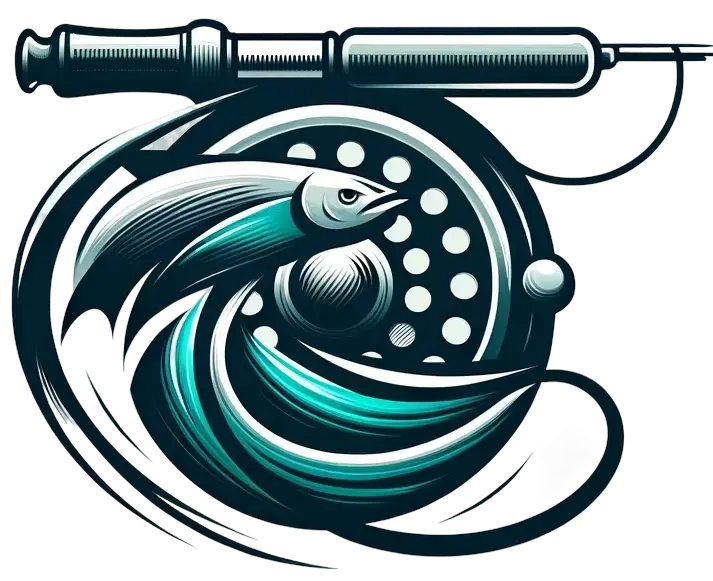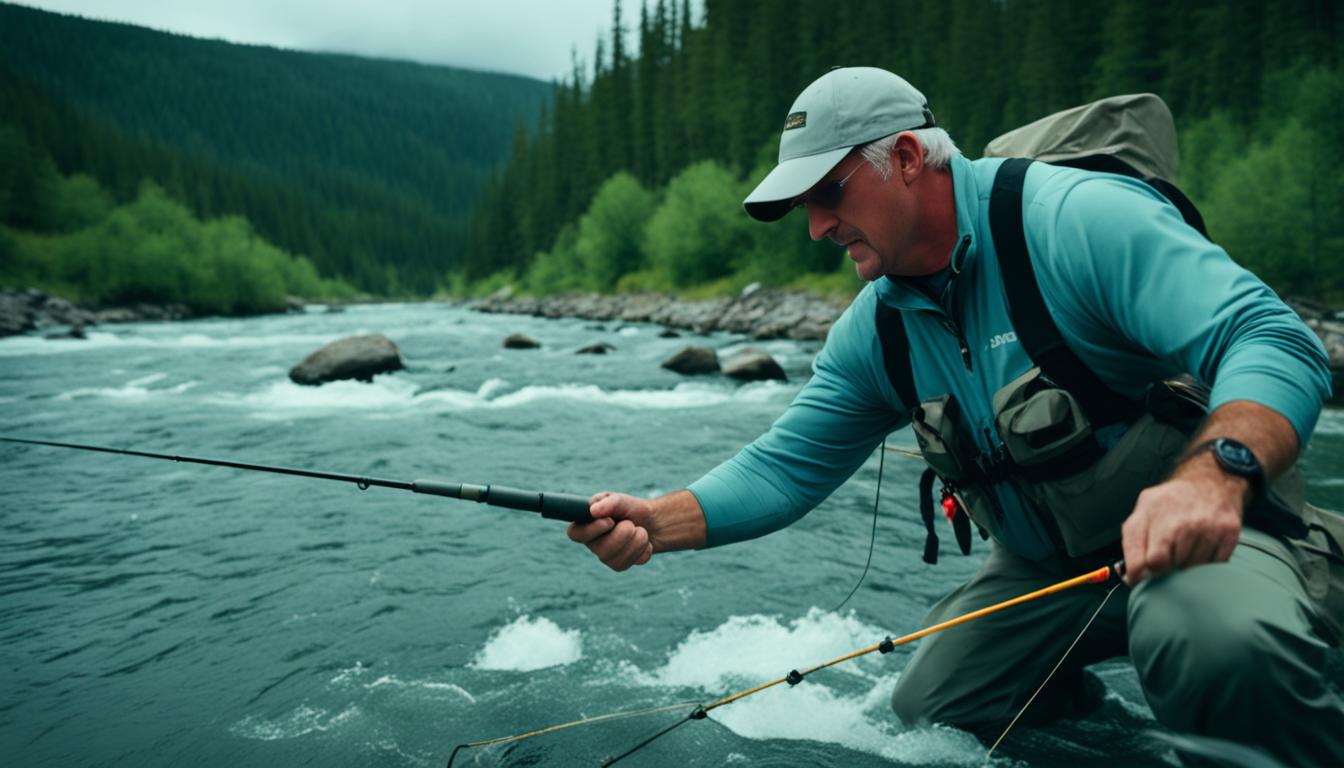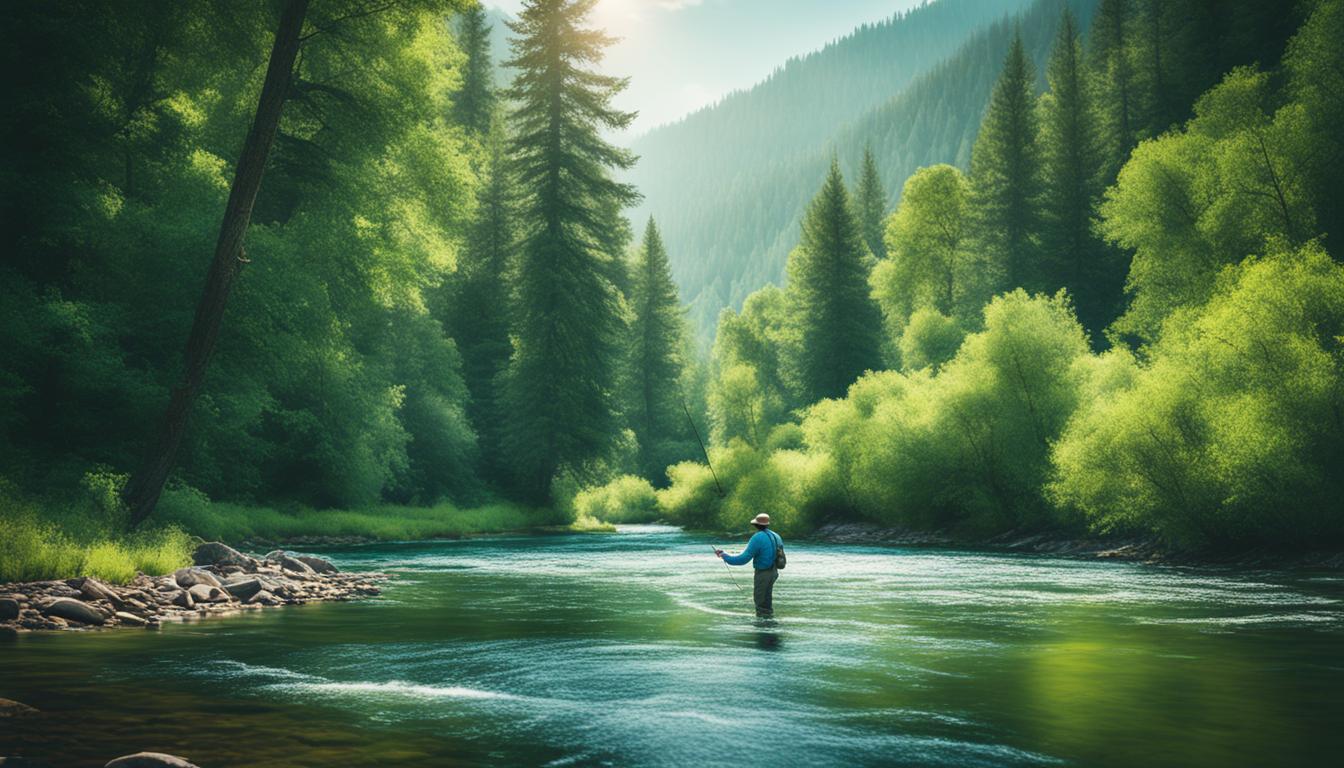Fly fishing in different seasons offers a unique opportunity to connect with nature and explore the ever-changing rhythms of the natural world. Understanding the nuances of each season is essential for mastering the art of fly fishing throughout the year. Whether you’re a seasoned angler or a beginner, join us on this journey as we uncover tips and techniques for fly fishing in every season.
Fly fishing is a sport that requires careful observation and adaptation. The key to successful fly fishing lies in understanding the habits of fish and the insects they feed on. By aligning your strategies with the seasonal patterns and conditions, you can increase your chances of hooking that trophy catch.
Key Takeaways:
- Each season presents unique challenges and opportunities for fly fishing.
- Matching the hatch and choosing the right fly patterns is crucial in spring.
- Summer is a prime time for dry fly fishing and utilizing terrestrials.
- In fall, focus on imitating larger prey and target migrating fish.
- Winter requires adjustments to fishing techniques and gear for colder conditions.
Spring Fly Fishing Tips
As winter fades away and the signs of spring begin to emerge, it’s time to dust off your fly fishing gear and embrace the excitement of the new season. Spring brings a sense of renewal, and the waters come alive with activity, making it an ideal time to indulge in the art of fly fishing.
During the spring months, as the ice recedes and nature awakens, it’s crucial to adapt your techniques to capitalize on the changing conditions. Here are some spring fly fishing tips that will help you make the most of this vibrant season:
Matching the Hatch
One of the keys to success in spring fly fishing is matching the hatch. As the ice melts and rivers begin to flow, insects come to life, providing a bountiful feast for fish. Take the time to observe the types of insects active on the water and choose fly patterns that closely resemble those found in the surroundings. By imitating the prevalent insects, you increase your chances of enticing fish to bite.
Fishing the Edges
During spring, fish often seek refuge in calmer waters along the banks. These edges provide them with a sense of security and access to abundant food sources. As a fly angler, you should concentrate your efforts on these areas, casting your flies towards the edges and allowing them to drift naturally along the current. By fishing the edges, you increase your chances of hooking into spirited fish.
Heavier Tackle for Increased Flow
Spring brings increased water flow due to melting snow and rain. To effectively control your flies in these conditions, it may be necessary to use heavier tackle. The weightier gear allows you to cast and present your flies accurately, mitigating the effects of the stronger currents. Consider using sturdier rods, weighted lines, and larger flies to combat the flow and target fish holding in deeper pockets.
By applying these spring fly fishing tips, you’ll be poised for success on the water during this exciting season. Remember to respect nature, practice catch-and-release, and enjoy the beauty of fly fishing in spring.
“Spring is the season of hope and the perfect time to immerse ourselves in the wonders of fly fishing. As the rivers awaken and life thrives, we find solace in the art of casting, chasing the elusive takes, and connecting with the rhythm of nature.”
| Fly Fishing Tips for Spring |
|---|
| Match the hatch by imitating prevalent insects |
| Fish the edges for better chances of hooking into fish |
| Use heavier tackle to control flies in the increased flow |
Summer Fly Fishing Tips
Summer is the perfect time for fly fishing, with warm weather and plenty of insect activity enticing fish to the surface. To make the most of your summer fly fishing adventures, we’ve compiled some valuable tips to help you succeed on the water.
Fishing During Optimal Hours
Planning your fishing expeditions during cooler dawn and dusk hours can greatly increase your chances of success. Fish tend to be more active during these times, as the temperature is lower, and they are actively feeding.
Choosing the Right Flies
During the summer months, dry flies and terrestrials like ants and beetles are prevalent. These patterns imitate the insects that are abundant during this season, making them highly effective. Be sure to have a variety of sizes and colors in your fly box to match the natural bugs present in the area you’re fishing.
Staying Stealthy
When fishing in shallower summer waters, it becomes crucial to stay stealthy and avoid making sudden movements that can spook fish. Keep a low profile, move slowly and quietly, and be mindful of your shadow. Maintaining a stealthy approach will increase your chances of catching wary fish.
Recommended Flies for Summer Fly Fishing
| Fly Pattern | Size | Color |
|---|---|---|
| Elk Hair Caddis | 12-18 | Tan, Olive |
| Parachute Adams | 12-18 | Gray |
| Hopper | 8-12 | Yellow, Green |
| Ant | 14-18 | Black, Red |
| Beetle | 12-16 | Black, Brown |
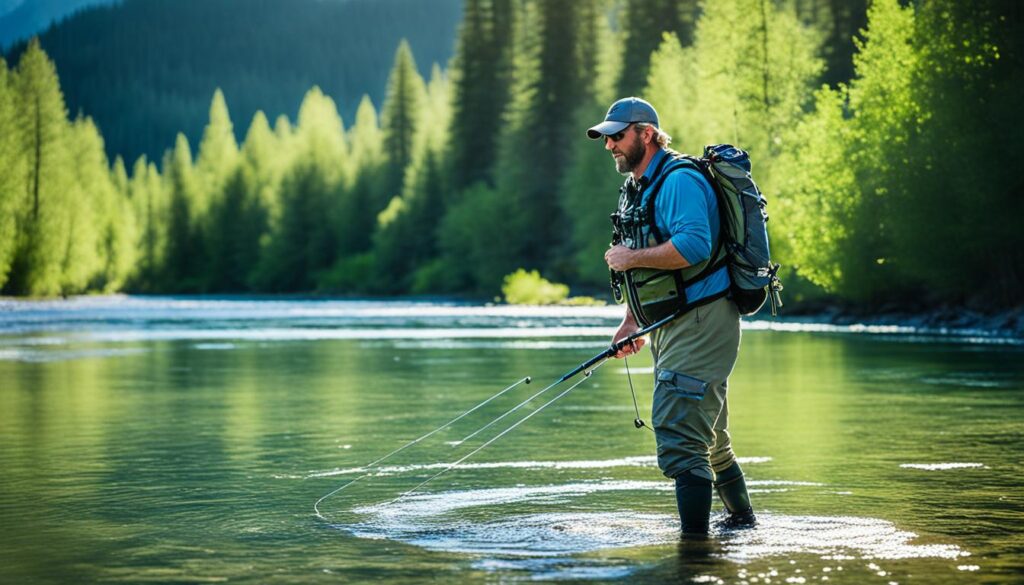
By following these summer fly fishing tips, you’ll be well-prepared to enjoy the prime fishing conditions and abundant insect life that the season has to offer. Remember to stay aware of changing water and weather conditions and adjust your techniques accordingly. Happy fishing!
Fall Fly Fishing Tips
As autumn sets in, we are presented with a unique opportunity to experience the beauty of nature and enjoy some incredible fly fishing. The changing colors of the foliage create a breathtaking backdrop as we cast our lines into rivers and streams teeming with life. In this section, we will uncover some valuable tips for successful fly fishing in the fall.
Streamers and Nymphs – Mimic the Feeding Frenzy
During the fall, fish become more aggressive in their feeding behavior as they prepare for the upcoming winter months. This presents the perfect opportunity to utilize streamers and nymphs that mimic larger prey, such as baitfish and insects. These patterns can trigger an instinctual response from the fish, often resulting in aggressive strikes.
When selecting streamers and nymphs, opt for natural colors that blend with the surroundings and effectively imitate the prey in the water. Remember to vary your retrieves to mimic the natural movement of the prey, enticing fish to strike.
Look for Migratory Fish
Fall is a time of migration for many fish species, including salmon and seatrout. These fish travel upstream in rivers and streams to spawn, presenting a fantastic opportunity for fly fishing enthusiasts. Research the migratory patterns of these fish in your region and target areas where they are known to congregate.
When fishing for migratory fish, it’s important to choose fly patterns that closely resemble the natural baitfish in the area. This not only increases your chances of success but also adds to the thrill of the experience as you witness these incredible creatures in their natural habitat.
Embrace the Vibrant Colors
One of the most captivating aspects of fall fly fishing is the stunning display of colors that nature treats us to. The vibrant hues of red, orange, and yellow create a surreal atmosphere, truly immersing us in the beauty of the season. Take a moment to appreciate the scenery and let it inspire you as you cast your line.
As you relish the visual feast, remember to adapt your fly selection to complement the changing environment. Choose patterns that mimic the colors and sizes of the insects and prey that are prevalent during this time of year.
| Essential Gear for Fall Fly Fishing | |
|---|---|
| Fishing Rod | A medium-fast action rod is ideal for versatile performance in varied fishing conditions. It provides the necessary power for casting heavier flies and is capable of handling larger fish. |
| Fly Selection | Ensure your fly box is well-stocked with a variety of streamers, nymphs, and dry flies that imitate the seasonal prey. This gives you the flexibility to adapt to changing feeding patterns and conditions. |
| Waders and Boots | Invest in reliable waterproof waders and comfortable boots to keep you dry and protected during your fall fishing adventures. |
| Layered Clothing | The weather in autumn can be unpredictable, so dress in layers that can be easily adjusted to accommodate changing temperatures throughout the day. |
Remember to always check the local regulations and obtain any necessary permits before heading out for your fall fly fishing excursions. With the right techniques, gear, and appreciation for the beauty of this season, you’ll discover a whole new level of enjoyment and success as you indulge in some autumn fly fishing.
Winter Fly Fishing Tips
Despite the challenges of winter, this season offers a serene beauty and solitude unmatched by any other time of year. While the thought of heading out for fly fishing in the colder months may seem daunting, with the right approach, it can be a rewarding and peaceful experience. Here are our winter fly fishing tips to make the most of this unique season:
-
Determine the Warmest Part of the Day
During winter, fish are more likely to feed during the warmest hours when the water temperature is slightly higher. Watch for signs of fish activity and plan your fishing sessions accordingly. Aim to be on the water during this time to increase your chances of success.
-
Present Flies Slowly and at Greater Depths
In colder water temperatures, fish tend to conserve energy, resulting in slower movement. Adjust your fly fishing techniques accordingly, presenting your flies more slowly and at greater depths to entice passive fish into striking. Be patient and make deliberate, controlled movements to maximize your effectiveness.
-
Dress Warmly and Stay Safe
When venturing out for winter fly fishing, it’s essential to dress appropriately to stay warm and comfortable. Layer your clothing to trap heat and insulate your body. Don’t forget to wear a warm hat, gloves, and cozy socks to protect extremities. Additionally, ensure you have the proper winter gear, such as ice cleats, to navigate potentially slippery terrain. Stay up-to-date with weather forecasts and be cautious of changing conditions.
“Winter fly fishing offers a unique opportunity to connect with nature in a peaceful and tranquil setting.”
Remember, winter fly fishing requires patience and adaptability. As you embrace the stillness of the season, you may be rewarded with the solitude and memorable fishing experiences that can only be found during this time of year.
| Fly Pattern | Description | Target Species |
|---|---|---|
| Woolly Bugger | A versatile streamer pattern that imitates various aquatic creatures | Trout, bass, panfish |
| Zebra Midge | A small, simple fly pattern that mimics midge larva | Trout |
| Pheasant Tail Nymph | An effective imitation of mayfly nymphs | Trout |
| Griffith’s Gnat | A tiny dry fly pattern perfect for imitating midges and other small insects | Trout |
Remember, successful winter fly fishing is not just about catching fish. It’s about immersing yourself in the beauty of the season, embracing the solitude, and enjoying the peacefulness of the natural world. So bundle up, head out to the water, and create memorable winter fly fishing experiences that will stay with you for a lifetime.
Year-Round Fly Fishing Gear
Successful fly fishing relies on having the right gear and equipment. At Orvis, we understand the importance of quality and versatility in your fly fishing setup. Here are some essential items to consider for your year-round fly fishing adventures:
Fly Fishing Gear:
- A Medium-Fast Action Rod: Choose a medium-fast action rod that offers a balance between power and sensitivity. This type of rod is versatile and suitable for various fly fishing techniques in all seasons.
- A Well-Stocked Fly Box: To match the ever-changing insect activity, keep a diverse selection of fly patterns in your fly box. This ensures you have the right fly for seasonal hatches, allowing you to effectively entice the fish.
- Quality Reel: A reliable reel with a smooth drag system is crucial for handling strong and elusive fish. Look for reels that are designed to withstand the demands of different seasons and fishing conditions.
- Strong Fishing Line: Choose a high-quality fishing line that matches the weight and action of your rod. Consider using floating, sinking, and intermediate lines depending on the fishing techniques and water conditions.
- Leader and Tippet Material: Have a range of leader and tippet materials in various sizes for different fishing scenarios. Opt for durable, low-visibility options to ensure a successful presentation.
Comfortable Apparel:
When venturing into the great outdoors, comfort and protection are essential. Invest in the following apparel to stay comfortable in varying weather conditions:
“The right gear sets the stage for an enjoyable fly fishing experience. Take the time to invest in high-quality gear that enhances your comfort and performance on the water.”
- Waterproof Waders: Keep yourself dry and comfortable with a pair of waterproof waders. These will protect you from cold water, provide insulation, and allow you to access areas that are otherwise challenging to reach.
- Comfortable Boots: A good pair of boots with adequate ankle support and traction is crucial for stability and safety. Look for boots that provide excellent grip on slippery riverbeds and can handle various terrains.
- Adjustable Layers: Layering your clothing is key to adapting to changing weather conditions. Invest in breathable, moisture-wicking base layers, insulating mid-layers, and waterproof outer layers to stay comfortable during your fly fishing trips.
- Sun Protection: Shield yourself from the sun’s harmful rays with a wide-brimmed hat, polarized sunglasses, and sunscreen. Protecting your skin and eyes is essential for prolonged enjoyment on the water.
- Fishing Vest or Pack: Keep your essential fly fishing tools and accessories organized and easily accessible with a fishing vest or pack. Look for features such as multiple pockets, attachment points, and comfortable straps for convenience on the water.
With the right gear, you’ll be well-prepared to tackle any fly fishing adventure throughout the year. Equip yourself with the essentials and make the most of each season’s unique fly fishing opportunities.
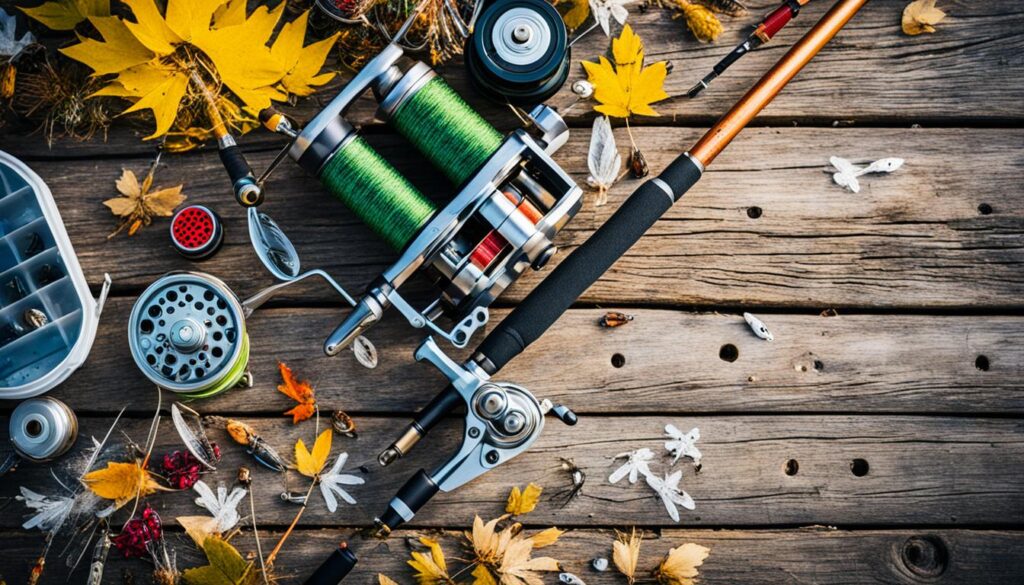
Fly Selection for Seasons:
| Season | Fly Selection |
|---|---|
| Spring | Nymphs, Wet Flies, and Emergers that match the hatching insects such as Mayflies, Caddisflies, and Stoneflies. |
| Summer | Dry Flies, Terrestrials, and Streamers. Use attractor patterns and imitations of aquatic insects like Midges, Ants, Beetles, and Grasshoppers. |
| Fall | Streamers, Nymphs, and Egg Patterns. Mimic the migrating prey such as Salmon Fry, Minnows, and Leeches. |
| Winter | Midges, Nymphs, and Emergers. Choose small, dark patterns that imitate winter insects like Chironomids. |
Matching your fly selection to the seasonal hatches and feeding patterns of the fish greatly increases your chances of success on the water. Stay informed about the local insect activity and adapt your fly choices accordingly.
Conclusion
The journey of fly fishing is a never-ending adventure, filled with excitement, challenges, and unforgettable experiences. As the seasons change, so do the opportunities and rewards that this sport offers. Understanding the unique aspects of each season enables us to adapt and embrace the rich tapestry of fly fishing experiences.
Whether it’s the vibrant renewal of spring, the abundant life of summer, the stunning colors of fall, or the serene beauty of winter, each season brings its magic to the Fly Fishing Adventure. By equipping ourselves with the right gear and knowledge, we can fully immerse ourselves in the wonders of nature and the thrill of the catch.
At Orvis, we’re here to support you throughout your fly fishing journey. Our range of gear, including versatile rods, well-stocked fly boxes, and high-quality waders, ensures that you’re prepared for any season and any challenge. We believe that every angler deserves a remarkable fly fishing experience, filled with joy, camaraderie, and connection to nature.
So, whether you’re chasing elusive trout in the spring, casting dry flies in the warm summer evenings, pursuing migrating fish in the fall, or braving the winter cold for moments of tranquility, we wish you tight lines and memorable Fly Fishing Adventures. Let’s explore the beauty and excitement of fly fishing together, season after season.
FAQ
What are some tips for fly fishing in spring?
To have a successful spring fly fishing excursion, it’s important to match the hatch and observe the types of insects active on the water. Fishing the edges where fish seek refuge in calmer waters near the banks can be beneficial. Heavier tackle may be necessary to control your flies in the increased flow of spring rivers.
What are some tips for fly fishing in summer?
During the summer, it’s best to plan your fishing expeditions during cooler dawn and dusk hours when fish are more active. Utilizing dry flies and terrestrials like ants and beetles, which are prevalent during this season, can prove effective. Stay stealthy and be mindful of your movements to avoid spooking fish in shallower summer waters.
What are some tips for fly fishing in fall?
In the autumn, fish feed aggressively to prepare for winter. Streamers and nymphs that mimic larger prey are effective during this season. Look for migrating fish like salmon and seatrout in rivers and streams with migratory patterns. Take advantage of the transition and enjoy the vibrant colors of fall while fly fishing.
What are some tips for fly fishing in winter?
Despite the challenges of winter, it offers a serene beauty and solitude unmatched by other seasons. It’s best to focus on fishing during the warmest part of the day when fish are more likely to feed. Adjust your techniques to present flies more slowly and at greater depths as fish conserve energy in the cold. Dress warmly and stay safe in winter conditions.
What gear is essential for year-round fly fishing?
Having the right gear is essential for a successful fly fishing experience. It is recommended to invest in a versatile setup with a medium-fast action rod that can be used in all seasons. Keep a well-stocked fly box with a variety of patterns to match different hatches. Additionally, waterproof waders, comfortable boots, and adjustable layers for varying weather conditions are indispensable.
